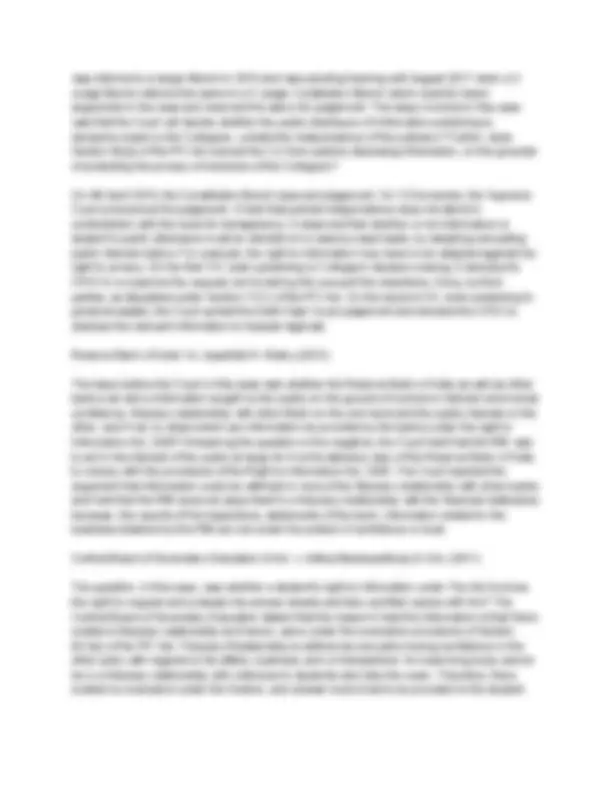





Study with the several resources on Docsity

Earn points by helping other students or get them with a premium plan


Prepare for your exams
Study with the several resources on Docsity

Earn points to download
Earn points by helping other students or get them with a premium plan
Community
Ask the community for help and clear up your study doubts
Discover the best universities in your country according to Docsity users
Free resources
Download our free guides on studying techniques, anxiety management strategies, and thesis advice from Docsity tutors
An overview of the Right to Information Act, 2005 in India. It explains the historical background, objectives, features, and exemptions of the Act. It also discusses two important cases related to the Act, Reserve Bank of India Vs. Jayantilal N. Mistry (2015) and Central Board of Secondary Education & Anr. v. Aditya Bandopadhyay & Ors. (2011).
Typology: Lecture notes
1 / 6

This page cannot be seen from the preview
Don't miss anything!




Right to Information Act, 2005 Introduction The right to information is implicitly guaranteed by the Constitution. However, with a view to set out a practical regime of securing information, the Indian Parliament enacted the Right to Information Act, 2005 and thus gave a powerful tool to the citizens to get information from the government as a matter of right. This law is very comprehensive and covers almost all matters of governance and has the widest possible reach, being applicable to government at all levels- union, state and local as well as recipients of government grants. Historical Background The right to information gained power when the Universal Declaration of Human Rights was adopted in 1948 providing everyone the right to seek, receive, information and ideas through any media regardless of frontiers. The International Covenant on Civil and Political rights 1966 states that everyone shall have the right to freedom of expression, the freedom to seek and impart information and ideas of all kinds. According to Thomas Jefferson “Information is the currency of democracy” and critical to the emergence and development of a vibrant civil society. However, with a view to set out a practical regime for the citizens to secure information as a matter of right, the Indian Parliament enacted the Right to Information Act, 2005. Genesis of RTI law started in 1986, through judgement of Supreme Court in Mr. Kulwal Vs. Jaipur Municipal Corporation case, in which it directed that freedom of speech and expression provided under Article 19 of the Constitution clearly implies Right to Information, as without information the freedom of speech and expression cannot be fully used by the citizens. Objectives of Right to Information Act, 2005 To empower the citizens To promote transparency and accountability To contain corruption To enhance people’s participation in democratic process Factors Responsible for Adoption of Information Act Corruption and scandals International pressure and activism Modernization and the information society Features of Right to Information Act, 2005 A citizen has a right to seek such information from a public authority which is held by the public authority or which is held under its control. This right includes inspection of work, documents and records; taking notes, extracts or certified copies of documents or records; and taking certified samples of material held by the public authority or held under the control of the public authority. It is important to note that only such information can be supplied under the Act which
already exists and is held by the public authority or held under the control of the public authority. The Public Information Officer is not supposed to create information; or to interpret information; or to solve the problems raised by the applicants; or to furnish replies to hypothetical questions. The Act gives the citizens a right to information at par with the Members of Parliament and the Members of State Legislatures. According to the Act, the information which cannot be denied to the Parliament or a State Legislature, shall not be denied to any person. A citizen has a right to obtain information from a public authority in the form of diskettes, floppies, tapes, video cassettes or in any other electronic mode or through print-outs provided such information is already stored in a computer or in any other device from which the information may be e-mailed or transferred to diskettes etc. The information to the applicant should ordinarily be provided in the form in which it is sought. However, if the supply of information sought in a particular form would disproportionately divert the resources of the public authority or may cause harm to the safety or preservation of the records, supply of information in that form may be denied. Some Information Seekers request the Public Information Officers to cull out information from some document(s) and give such extracted information to them. A citizen has a right to get ‘material’ from a public authority which is held by or under the control of that public authority. The Act, however, does not require the Public Information Officer to deduce some conclusion from the ‘material’ and supply the ‘conclusion’ so deduced to the applicant. It means that the Public Information Officer is required to supply the ‘material’ in the form as held by the public authority, but not to do research on behalf of the citizen to deduce anything from the material and then supply it to him or her, as the case may be. Information Exempted from Disclosure Sub-section (1) of section 8 and section 9 of the Act enumerate the type of information which is exempted from disclosure. Sub-section (2) of section 8, however, provides that information exempted under sub-section (1) or exempted under the Official Secrets Act, 1923 can be disclosed if public interest in disclosure overweighs the harm to the protected interest. The information which, in normal course, is exempt from disclosure under sub-section (1) of Section 8 of the Act, would cease to be exempted if 20 years have lapsed after occurrence of the incident to which the information relates. However, the following types of information would continue to be exempt and there would be no obligation, even after lapse of 20 years, to give any citizen: Information disclosure of which would prejudicially affect the sovereignty and integrity of India, the security, strategic, scientific or economic interest of the State, relation with foreign state or lead to incitement of an offence; Information the disclosure of which would cause a breach of privilege of Parliament or State Legislature; or cabinet papers including records of deliberations of the Council of Ministers, Secretaries and other Officers subject to the conditions given in proviso to clause (i) of sub-section (1) of Section 8 of the Act.
The Right to Information Act, 2005 did not create a new bureaucracy for implementing the law. Instead, it tasked and mandated officials in every office to change their attitude and duty from one of secrecy to one of sharing and openness. It carefully and deliberately empowered the Information Commission to be the highest authority in the country with the mandate to order any office in the country to provide information as per the provisions of the Act. It empowered the Commission to fine any official who did not follow the mandate. Right to information has been seen as the key to strengthening participatory democracy and ushering in people centred governance. Access to information can empower the poor and the weaker sections of society to demand and get information about public policies and actions, thereby leading to their welfare. Right to information opens up government’s records to public scrutiny, thereby arming citizens with a vital tool to inform them about what the government does and how effectively, thus making the government more accountable. Improves decision making by public authority by removing unnecessary secrecy which prevails in the offices. Challenges Different types of information are sought which have no public interest and sometimes can be used to misuse the law and harass the public authorities. For example- Asking for desperate and voluminous information. To attain publicity by filing RTI Applications RTI filed as vindictive tool to harass or pressurise the public authority Because of the illiteracy and unawareness among the majority of the population in the country, the RTI cannot be exercised Though RTI’s aim is not to create a grievance redressal mechanism, the notices from Information Commissions often spur the public authorities to redress grievances Supreme Court Cases Relating to RTI, 2005 Namit Sharma Vs. Union of India (2013) In this case, a Public Interest Litigation was filed before the honourable the Supreme Court saying that Right to Information has a new regime in the offices, in State and Central Commissions. When it comes to Commissions, there are certain legal technicalities which can only be understood by the law graduates, lawyer or legally skilled people. Central Public Information Officer, Supreme Court of India Vs. Subhash Chandra Agarwal, 2019 SCC (5 Judges Bench) In this case, the respondent has asked for the information pertaining to the decision-making process by the Supreme Court Collegium. Though the operation of the order of the Central Information Commission (CIC) was stayed by the Supreme Court in December 2009, the case
was referred to a larger Bench in 2010 and was pending hearing until August 2017 when a 3 Judge Bench referred the same to a 5 Judge Constitution Bench which recently heard arguments in the case and reserved the same for judgement. The issue involved in this case was that the Court will decide whether the public disclosure of information pertaining to decisions made by the Collegium, curtails the independence of the judiciary? Further, does Section 8(i)(j) of the RTI Act exempt the CJI from publicly disclosing information, on the grounds of protecting the privacy of members of the Collegium? On 4th April 2019, the Constitution Bench reserved judgement. On 13 November, the Supreme Court pronounced its judgement. It held that judicial independence does not stand in contradiction with the need for transparency. It observed that whether or not information is subject to public disclosure must be decided on a case-by-case basis, by weighing competing public interest claims. For example, the right to information may have to be weighed against the right to privacy. On the first CIC order pertaining to Collegium decision-making, it directed its CPIO to re-examine the request, but by taking into account the objections, if any, by third parties, as stipulated under Section 11(1) of the RTI Act. On the second CIC order pertaining to personal assets, the Court upheld the Delhi High Court judgement and directed the CPIO to disclose the relevant information to Subash Agarwal. Reserve Bank of India Vs. Jayantilal N. Mistry (2015) The issue before the Court in this case was whether the Reserve Bank of India as well as other banks can deny information sought by the public on the ground of economic interest commercial confidence, fiduciary relationship with other Bank on the one hand and the public interest on the other, and if not, to what extent can information be provided by the banks under the right to Information Act, 2005? Answering the question in the negative, the Court held that the RBI was to act in the interest of the public at large for it is the statutory duty of the Reserve Bank of India to comply with the provisions of the Right to Information Act, 2005. The Court rejected the argument that information could be withheld in view of the fiduciary relationship with other banks and held that the RBI does not place itself in a fiduciary relationship with the financial institutions because, the reports of the inspections, statements of the bank, information related to the business obtained by the RBI are not under the pretext of confidence or trust. Central Board of Secondary Education & Anr. v. Aditya Bandopadhyay & Ors. (2011) The question, in this case, was whether a student’s right to information under The Act involves the right to request and evaluate his answer sheets and take certified copies with him? The Central Board of Secondary Education stated that the reason it held the information is that there existed a fiduciary relationship and hence, came under the exemption provisions of Section 8(1)(e) of the RTI Act. Fiduciary Relationship is defined as one party having confidence in the other party with regards to his affairs, business, and or transactions. An examining body cannot be in a fiduciary relationship with reference to students who take the exam. Therefore, there existed no exemption under the Section, and answer books had to be provided to the student.